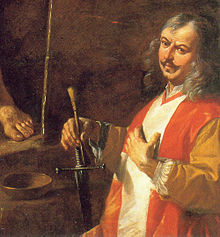Mattia Preti
Mattia Preti | |
|---|---|
 Il Cavalier Calabrese | |
| Born | (1613-02-24)24 February 1613 Taverna, Calabria, Italy |
| Died | 3 January 1699(1699-01-03) (aged 85) Valletta, Malta |
| Nationality | Italian |
| Style | Baroque painting |
Mattia Preti (24 February 1613 – 3 January 1699) was an Italian Baroque artist who worked in Italy and Malta. He was appointed a Member of the Order of Saint John.
Contents
1 Life
2 References
3 Further reading
4 External links
Life

St George on Horseback, St. John's Co-Cathedral, Valletta
Born in the small town of Taverna in Calabria, Preti was called Il Cavalier Calabrese (the Calabrian Knight) after appointment as a Knight of the Order of St. John (Knights of Malta) in 1660.[1] His early apprenticeship is said to have been with the "Caravaggist" Giovanni Battista Caracciolo, which may account for his lifelong interest in the style of Caravaggio.
Probably before 1630, Preti joined his brother Gregorio (also a painter), in Rome, where he became familiar with the techniques of Caravaggio and his school as well as with the work of Guercino, Rubens, Guido Reni, and Giovanni Lanfranco. In Rome, he painted fresco cycles in the churches of Sant'Andrea della Valle and San Carlo ai Catinari. Between 1644 and 1646, he may have spent time in Venice,[2] but remained based in Rome until 1653, returning later in 1660–61. He painted frescoes for the church of San Biagio at Modena (app. 1651–2) and participated in the fresco decoration of the Palazzo Pamphilj in Valmontone (documented 1660–61), where he worked along with Pier Francesco Mola, Gaspar Dughet, Francesco Cozza, Giovanni Battista Tassi (il Cortonese), and Guglielmo Cortese.

The Wedding at Cana, National Gallery, London

The Martyrdom of St. Bartholomew, painted in Naples around 1650 by Mattia Preti. In the early 19th century, Francis I of the Two Sicilies gave the painting to the Basilica of St. Joseph Proto-Cathedral in Bardstown, Kentucky.

The Concert, Hermitage Museum
During most of 1653–1660, he worked in Naples, where he was influenced by another major painter of his era, Luca Giordano. One of Preti's masterpieces were a series of large frescoes, ex-votos of the plague (which were painted on seven city gates but have since been lost to the ravages of time), depicting the Virgin or saints delivering people from the plague. Two sketches are in the Capodimonte Museum in Naples.[3] The bozzetto of the Virgin with the baby Jesus looming over the dying and their burial parties envisions a Last Judgement presided over by a woman.[4] Preti also won a commission to supervise the construction, carving, and gilding for the nave and transept of San Pietro a Maiella.
Having been made a Knight of Grace in the Order of St John, he visited the order’s headquarters in Malta in 1659 and spent most of the remainder of his life there. Preti transformed the interior of St. John's Co-Cathedral in Valletta with a huge series of paintings on the life and martyrdom of St. John the Baptist (1661–1666). In Malta one also can find many paintings of Preti in private collections and in parish churches. His increased reputation led to an expanded circle of patrons, and he received commissions from all over Europe.[5][6]
Preti was fortunate to enjoy a long career and have a considerable artistic output. His paintings, representative of the exuberant late Baroque style, are held by many great museums, including important collections in Naples, Valletta, and in his hometown of Taverna.
References
^ John T. Spike, Mattia Preti: I Documenti, Florence: 1999.
^ Wittkower, 360
^ James Clifton, "Mattia Preti's Frescoes for the City Gates of Naples," Art Bulletin (1994), 479–501
^ Clifton, 480. Preti's salary for the work was 1500 ducats.
^ Bonello, Giovanni (2000). Art in Malta – Discoveries and Recoveries. Fondazzjoni Patrimonju Malti. p. 69-102. .mw-parser-output cite.citationfont-style:inherit.mw-parser-output qquotes:"""""""'""'".mw-parser-output code.cs1-codecolor:inherit;background:inherit;border:inherit;padding:inherit.mw-parser-output .cs1-lock-free abackground:url("//upload.wikimedia.org/wikipedia/commons/thumb/6/65/Lock-green.svg/9px-Lock-green.svg.png")no-repeat;background-position:right .1em center.mw-parser-output .cs1-lock-limited a,.mw-parser-output .cs1-lock-registration abackground:url("//upload.wikimedia.org/wikipedia/commons/thumb/d/d6/Lock-gray-alt-2.svg/9px-Lock-gray-alt-2.svg.png")no-repeat;background-position:right .1em center.mw-parser-output .cs1-lock-subscription abackground:url("//upload.wikimedia.org/wikipedia/commons/thumb/a/aa/Lock-red-alt-2.svg/9px-Lock-red-alt-2.svg.png")no-repeat;background-position:right .1em center.mw-parser-output .cs1-subscription,.mw-parser-output .cs1-registrationcolor:#555.mw-parser-output .cs1-subscription span,.mw-parser-output .cs1-registration spanborder-bottom:1px dotted;cursor:help.mw-parser-output .cs1-hidden-errordisplay:none;font-size:100%.mw-parser-output .cs1-visible-errorfont-size:100%.mw-parser-output .cs1-subscription,.mw-parser-output .cs1-registration,.mw-parser-output .cs1-formatfont-size:95%.mw-parser-output .cs1-kern-left,.mw-parser-output .cs1-kern-wl-leftpadding-left:0.2em.mw-parser-output .cs1-kern-right,.mw-parser-output .cs1-kern-wl-rightpadding-right:0.2em
ISBN 99909-959-7-4.
ISBN 99909-959-8-2.
^ Alessandro Cosma. Paintings for the Knights of Malta. Mattia Preti and the Celebration of Martyrdom. Actual Problems of Theory and History of Art: Collection of articles. Vol. 6. Eds: Anna V. Zakharova, Svetlana V. Maltseva, Ekaterina Yu. Stanyukovich-Denisova. St. Petersburg, NP-Print Publ., 2016, pp. 468–473. ISSN 2312-2129.
Further reading
Spike, John (1997). Mattia Preti e Gregorio Preti a Taverna. Catalogo completo delle opere. Centro Di.
Spike, John (1999). Mattia Preti. Catalogo Ragionato dei Dipinti. Florence.
Wittkower, Rudolf (1993). "Art and Architecture Italy, 1600–1750". Pelican History of Art. 1980. Penguin Books Ltd. pp. 330–331.
External links
| Wikimedia Commons has media related to Mattia Preti. |

